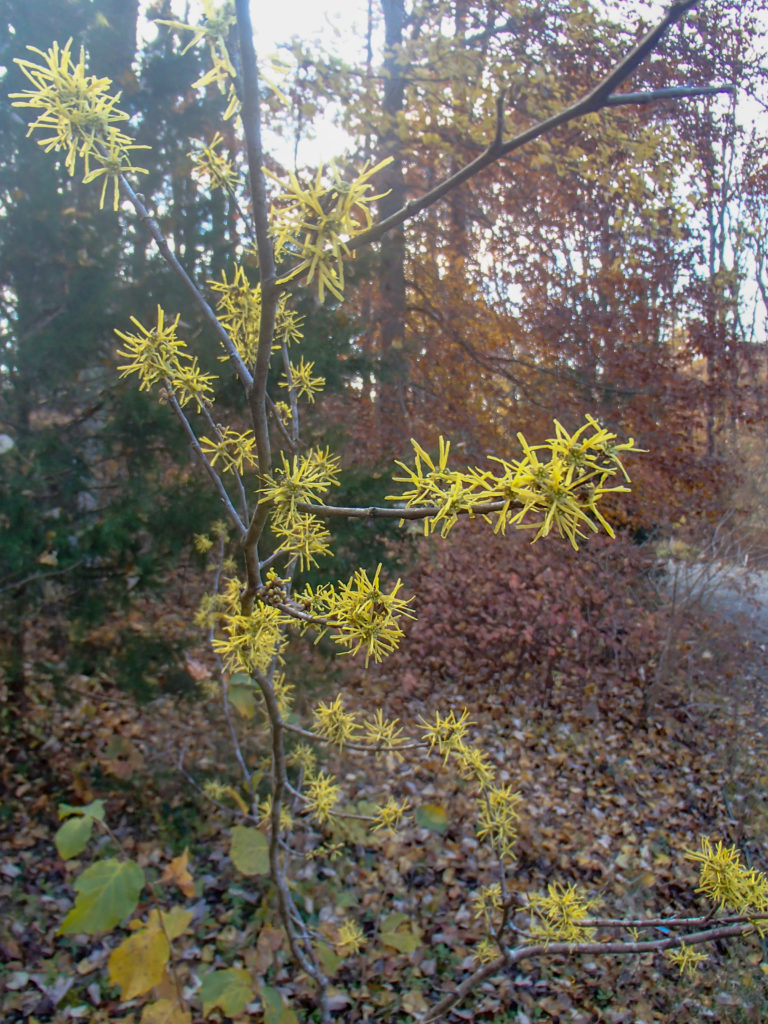Common Witchhazel is a deciduous shrub 12-18′ tall, and sometimes taller, famous for producing its aromatic, crinkly yellow flowers as it drops its foliage in late October/early November. Seeds from the previous season are ready for dispersal at the same time, and are expelled with some force from their capsules. Witchhazel can be single-stemmed with a trunk up to 1 foot across, or have several somewhat twisted basal stems, forming an irregular open crown. It occurs throughout eastern North America, from Nova Scotia to Florida and from the Great Lakes to eastern Texas. Early settlers learned from Native Americans how to use forked limbs of the Witchhazel as dowsing or divining rods, a practice that persists into our science-dominated era. Also, the bark is still gathered in large quantities in the Southern Appalachians, as the source for witchhazel liniment. But this interesting shrub is grown most often because of its spark of fresh, bright yellow flowers at a moment when all else of color has faded from the woods. Witchhazel is an understory plant and greatly prefers rich, moist soils in dappled sunlight, as on a north-facing slope, though full light can stimulate more flowering if soil moisture is sufficient.
NURSERY HOURS
Wednesday: 10-4 Thursday: 10-6 Friday-Saturday: 10-4 Sunday: 12-4
Hamamelis virginiana

Key Info
Scientific Name: Hamamelis virginiana L.
Common Names: Witchhazel Witch-hazel, American Witch-hazel, Common Witch-hazel, Winterbloom, Snapping Hazelnut, Striped Alder, Spotted Alder, Tobacco-wood, Water-witch
Family Names: Hamamelidaceae
Plant Type: Tree / Shrub
Moisture Requirement: Moist well drained
Leaf Retention: Deciduous
Flower Color: Yellow
Special Characteristics: Tolerates shade, Tolerates wet soils, Flowers fragrant, Tolerates poor soil, Good fall color, Tolerates urban pollution, Attracts birds, Foliage fragrant
Additional Info
Habit: This shrub may be single-stemmed or have several branched basal stems. Branches are often crooked, forming an irregular, open crown, with medium texture. Bark is smooth and gray. The root system is a branched taproot. Witchhazel spreads by seeds.
Height: 12-18'
Spread: 12-18'
Soil Conditions: Moist, acidic, organically rich, well-drained soils: sandy, sandy loam, medium loam, clay loam, clay
Leaves: Leaves are alternate, simple, broadly oval, 2.5 to 6 inches long, the base often asymmetrical, with dentate to wavy margins and with the upper surface dark green and the lower surface a paler green. In fall they turn warm golden before dropping.
Flowers (or reproductive structures: Flowering begins in about the sixth year. The flowers, which exude a spicy fragrance, appear on upper branches. They consist of 4 very slender, creamy-to-bright yellow, straplike petals ½ to ¾ inch long, 4 smaller sepals, 4 fertile stamens and a pair of short styles. The petals of often contorted.These appear in mid to late fall, lasting 2-3 weeks.
Fruit: Fertilized flowers will form fruit which begin as greenish seed capsules and become woody with age. Each seed capsule splits open in fall of the following year (during flowering), exploding the seeds within up to 20 or even 30 feet. Seeds are about ¼ inch long, ellipsoid, shiny, and black. Once ejected, the seeds then take an additional year to germinate.
Natural Distribution: Moist woods, thickets, bottomlands
USDA Hardiness Zone: 3-8
USDA Wetland Indicator Status in NC: FACU
Pollination: Flowers are pollinated by winter-flying noctuid moths.
Wildlife Connections: The nectar and pollen of the flowers attract primarily flies and wasps, as well as bees, bugs, moths and beetles. A long list of other insects (weevils, leafhoppers, more beetles, gall flies, aphids etc.) feed on the leaves. Song birds, Ruffed Grouse, Wild Turkey, Fox, Squirrel and other small mammals eat the fruits (small brown capsules). Cottontail Rabbits browse on seedlings. White-tailed deer browse the leaves and seed capsules.Witch Hazel provides cover and nesting habitat for the Indigo Bunting and probably other birds.(Illinoiswildflowers.info)
Propagation: American witchhazel can be grown from seeds that have been cold stratified.
